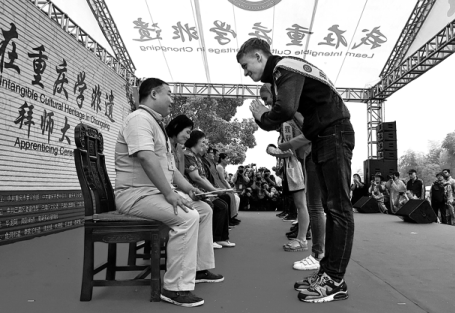Inheritors of nation's intangible cultural heritage welcome foreign apprentices

CHONGQING-In Banan district of Southwest China's Chongqing, people from Benin, Bangladesh, Ukraine and Russia presented "apprenticeship application letters "and served tea to their teachers.
It was a traditional apprenticeship acceptance ritual, by which they became the official apprentices of the inheritors of Mudong folk songs, Yanxing paper-cutting, pyrography and other forms of Chinese intangible cultural heritage.
Having lived in China for just two months and barely speaking the language, Rubtsova Aleksandra from Ukraine was captivated by the Mudong folk songs and became an apprentice of Yu Lianghua, an inheritor of the art form that dates back to ancient times.
"I am intrigued by the melodic tunes and the beautiful stories behind them," she says.
"Back then, the folk songs were exactly like pop songs today. We used to sing them after the farm work to entertain ourselves," says Yu, 78.
Yu first came to know the Mudong folk songs more than 60 years ago. He has taught many people to sing them, including school pupils and his own neighbors. Three years ago, he met his first class of foreign apprentices.
"My apprentices came from all over the world, and they are all interested in Chinese culture," Yu says. He not only teaches his foreign apprentices how to sing in the Mudong dialect, but also explains the stories and emotions behind the lyrics.
"We may not speak the same language, but we share the same feelings for the music," Yu says.
Now Yu has over 50 apprentices from countries including the United States, France and Russia. Besides face-to-face classes, he also teaches online courses.
Teaching foreign students will expand the influence of Chinese intangible cultural heritage and extend the appeal of Chinese culture to more countries, Yu says.
This year marks the 10th anniversary of the implementation of the Law on Intangible Cultural Heritage. Over the past decade, the Chinese government has placed great importance on the preservation of cultural heritage and ethnic cultures.
The country has established a tiered system of intangible cultural heritage, spanning the national, provincial, municipal and county levels.
More than 100,000 items have been registered in the system, including 1,372 at the national level. A total of 3,068 individuals are identified as representative trustees of national intangible cultural heritage, official statistics show.
From traditional Chinese music, dance and acrobatics to calligraphy, woodcarving, porcelain and embroidery, Chinese intangible cultural heritage has been put on the map for its exquisite craftsmanship and delicate art.
"Intangible cultural heritage is an important way for me to better understand China," says Otabek Ashrapov, a Russian student who is skilled in Chinese calligraphy.
Xinhua


Today's Top News
- The US 2025: a year of deep division
- China to expand fiscal spending in 2026: finance minister
- China's finance minister pledges expanding fiscal spending in 2026
- CPC leadership meeting urges steadfast implementation of eight-point decision on improving conduct
- Autumn grain purchases exceed 200m tons in China
- Wang to meet foreign ministers of Cambodia, Thailand in Yunnan






























